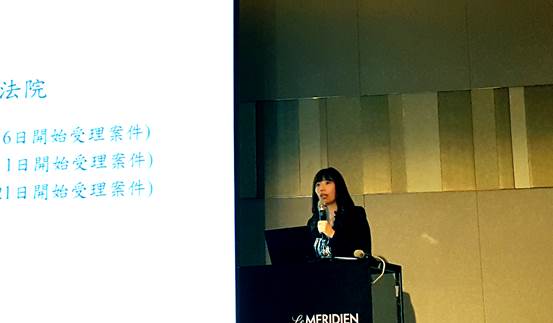
Winona Chen at the Patent Practice Seminar in Taipei; Photo by Conor Stuart
Winona Chen, a lawyer with Taiwan-based law firm Lee and Li Attorneys at Law gave a presentation at a recent conference outlining the main differences between the Intellectual Property Courts established in China at the end of 2014, and the Intellectual Property Court established in Taipei in 2008 and their respective impact on IP practice. The talk has been summarized in English below.
There are around eight judges working in the Court of First Instance of Taiwan’s Intellectual Property Court and eight for the Court of Second Instance, as well as 13 technical examination officers.
The court is laid out as shown in Figure 1 below.
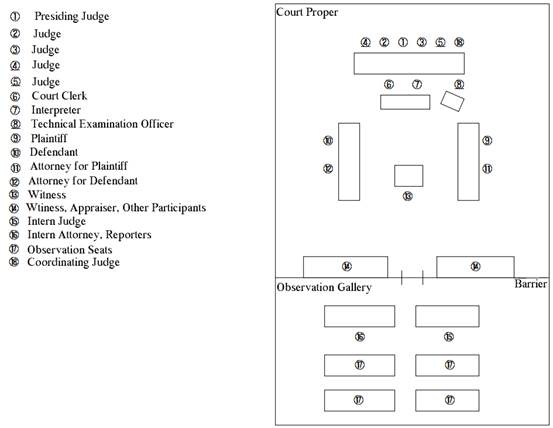
Figure 1: Layout of the Intellectual Property Court;
Source: Website of the Intellectual Property Court
At the Court of First Instance there is normally just one judge sitting, the other four judges are present normally for cases of the second instance.
The cases the court hears can be divided into three large categories (See Figure 2). The first is civil suits of both the first and second instance. In terms of criminal suits, it serves only as a court of second instance. So for IP-related criminal cases, the case of first instance will be held at the district court. Then there are also administrative cases, such as appealing a refusal to grant a patent by the patent office or validity issues. First the Taiwan Intellectual Property Office will take administrative action; this is then appealed to the Petitions and Appeals Committee of the Ministry of Economic Affairs. Administrative action taken by this committee can then be appealed to the Taiwan Intellectual Property Court on first instance. Civil suits on the second instance are subsequently referred to the Supreme Court, as are criminal cases at the second instance. Administrative cases of the first instance are referred directly to the Supreme Administrative Court on appeal.

Figure 2: IP case procedure for the Taiwan Intellectual Property Court;
Source: Taiwan Intellectual Property Court Website
As to judgment of patent validity, Taiwan has a two-track system. Two-track in that after the Taiwan Intellectual Property Office has made a decision on the validity of a patent, the Taiwan Intellectual Property Court can make a decision on patent validity itself.
We can see that in terms of the court, if the court makes a judgment on validity and the patent holder or another party wish to appeal, they can appeal to the court of second instance and finally to the Supreme Court, with each hearing taking around a year. With the Taiwan Intellectual Property Office route, the litigant initiates validity proceedings with the Taiwan Intellectual Property Office, which takes two years. If they are unhappy with the result they can appeal to the Ministry of Economic Affairs, which takes 3 months, but this is extendable to 5 months. On appeal this will be referred to the Taiwan Intellectual Property Court court of first instance, which takes 6 months, and then is referred to the Supreme Administrative Court, which takes a year. The court route is the quickest in terms of the pace at which decisions come down, but there is a difference between the two decisions. In terms of the IPO, it is concerned with examining patents for validity as its main work, so the decision it makes on the validity of a patent is effective against any person. If it’s the court, on the other hand, the decision only involves the parties in litigation. So even if it goes to the Supreme Court, it only applies to that specific lawsuit. So the courts are quicker, but the decision only applies to the litigants.
In practice this two-track system has started to evolve. The Intellectual Property Office will wait for the court’s decision as it’s the Intellectual Property Court that oversees the decisions of the Intellectual Property Office. Therefore it makes sense to just wait on their decision and then follow along with it. So even though technically it is a two-track system, normally there’s a time delay. Normally the IPO will wait for the Intellectual Property Court to issue a decision and will decide in line with the decision of the court. If it’s your patent that is at risk of being invalidated, you have to put your all into this suit, as it’s not just this suit that will be decided as a result, as the IPO may decide to follow the decision of the court.
When one party files suit against another in the court of first instance, there is a two-week period, during which the Taiwan Intellectual Property Court will set up a procedural court, to deal with any injunctions the patent holder may want to file, to prevent the infringer continuing to produce the alleged infringing product. They will also decide how the litigation fees will be calculated. After this procedural court has decided on this, there will be a four month period, during which the defendant and the claimant exchange pleas. It’s only when this exchange has progressed to a certain stage that a judge will be assigned to the case and it will be given a case number. When the case is being heard, it will take from six to eight months for a verdict to come down, with each hearing spaced out by a month to a month and a half. From last year onwards, there has been an internal policy within the Intellectual Property Court, to make initial opinions on issues like validity, infringement and compensation while proceedings are ongoing, according to Chen. It doesn’t end the proceedings but just gives litigants the opinion of the court at that point in time. As soon as these decisions come down, if the court states that it thinks that the patent is valid, for instance, then the person accused of infringement might reconsider continuing with the lawsuit or whether they should come to agreement with the patent holder. This really encourages both parties to come to a settlement, said Chen. And the number of in-process decisions has increased with time. On average this comes down around the middle of proceedings, at 3.5 months. There can be several in one case, however, one for the validity of the patent, one for infringement, and so on.
China’s court system, on the other hand, is a four tier system: the Basic People’s Court; the Intermediate People’s Court, the High People’s Court and the Supreme People’s Court. In principle then, the court of first instance is the Basic People’s Court and then the second instance will be heard at the Intermediate People’s Court and so on. But in practice, all four courts can serve as courts of first instance depending on the importance of the case. So where do the three Chinese Intellectual Property Courts fit into this structure? They serve as equivalents to Intermediate People’s Courts.
Court Name |
Number of Judges |
Number of Technical Examiners |
Beijing Intellectual Property Court |
43 |
39 |
Shanghai Intellectual Property Court |
14 |
11 |
Guangzhou Intellectual Property Court |
13 |
Unknown |
Figure 3: Staffing of each of China’s Intellectual Property Courts
As well as the Technical Examiners who serve as technical assistants to judges (see Figure 3), there are also technical experts and consultants hired by the court.
The difficulty with the Chinese system, according to Chen, is that things often work as exceptions to the principle as to how they should work.
Intellectual property courts deal with civil and administrative cases involving patents, copyright, trademarks, trade secrets, new plant varieties, software and IC layout design. They also have jurisdiction over administrative cases involving anti-competitive practices.
Now the Intermediate People’s Courts of Shanghai and Beijing no longer hear cases involving intellectual property and cases of the first instance in these two cities are referred to the Intellectual Property Courts. The Guangzhou court has jurisdiction for cases from all over the whole of Guangdong Province for intellectual property cases with the exception of the jurisdiction of the Shenzhen Intermediate People’s Court. This can be contrasted with Taiwan where intellectual property cases from all over the island can be heard by the Intellectual Property Court.
The Beijing Intellectual Property Court has another specialized role. As well as civil and administrative suits, it also is responsible for administrative appeals on a refusal by the State Intellectual Property Office to grant a patent.
In China, intellectual property courts are laid out as below:
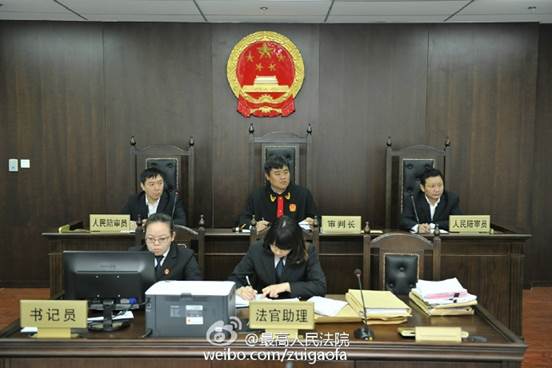
Photo: From back left: Lay Judge, Presiding Judge, Lay Judge; Front row from left: Court Clerk, Judge’s Assistant at the Intellectual Property Section of the Supreme People’s Court; Source: The Supreme Court’s Weibo Account
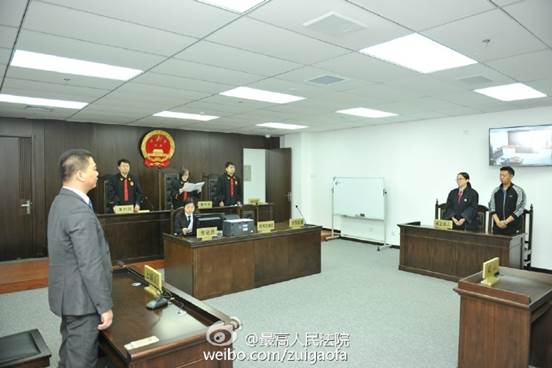
Photo: The Intellectual Property Section of the Supreme People’s Court;
Source: The Supreme Court’s Weibo Account
One of the more unique aspects of the Chinese court system in the presence of “lay judges”. Lay judges are non-professional judges that are appointed for five-year terms, but can never be the main judge in a proceeding.
When appealing a patent’s validity in China, the appeal goes to the State Intellectual Property Office’s Board of Patent Appeals and Interferences. If they are not satisfied with this result, it goes to the Beijing Intellectual Property Court and then subsequently to the Intellectual Property Section of the Beijing High Court. If an infringer files invalidity proceedings during an infringement trial, however, it can go to certain specified Basic People’s Courts and then on appeal to one of the three Intellectual Property Courts, or to the provincial, city or regional Intermediate People’s Courts. Alternatively on first instance it can go straight to one of the three intellectual property courts or to the provincial, city or regional Intermediate People’s Courts and then on appeal to the intellectual property section of the High People’s Court on second instance.
In Taiwan, at most a case can be heard three times, but in China it can only be heard twice in court.
Cases involving high costs or new kinds of cases are most likely to be heard at the High People’s Court on first instance.
A relatively unique problem in China is having a case accepted for trial by the court you file with. In Taiwan, if you wish to file litigation, you file it with the court and it gets scheduled. In China, they first require approval and certain conditions must be met before a case can proceed. So this has become a skill lawyers must be equipped with in China. Sometimes cases won’t be permitted just because of the sheer number of applications, so Chinese lawyers use their case establishment rate as a way to attract clients. The problem of filing a case is even a problem on appeal.
In China, in the court of second instance (also the final instance) they also reexamine the facts of the case, which is not the case in Taiwan. In China, first instance suits must be completed within 180 days, while appeals must be completed within a 90 day limit, which is extremely quick, but this often is not the case in reality.
In Taiwan the average number of days for the first instance of a civil case was 278.28 in 2015 (see Table 1), compared to an average of 259 days for patent cases, 169 days for trademark cases and 209 days for copyright cases on the first instance at the Intellectual Property Court in Beijing in 2015 (See Figure 4). The average for a civil case at second instance at the Taiwan Intellectual Property Court was 253.7 days (see Table 2), compared to 89 days for patent cases, 80 days for trademark cases and 63 days for copyright cases at the Beijing Intellectual Property Court.
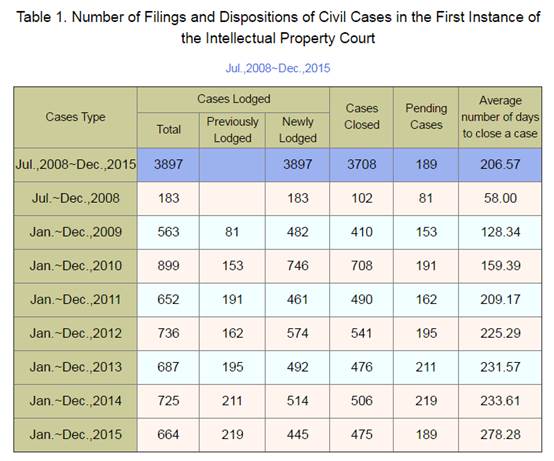
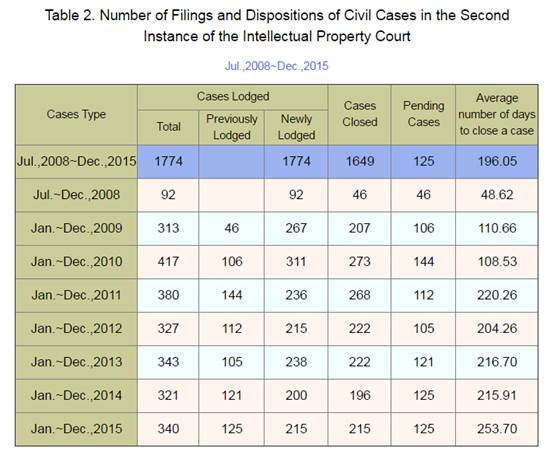

Figure 4: Length of Legal Proceedings in Days by Case Type at Beijing Intellectual Property Court;
Source: IPHouse Judicial Data Research Center
The average number of days for administrative cases at the Taiwan Intellectual Property Court in 2015 was 185.5, compared to an average of 180 days for administrative patent cases of the first instance and 128 days for administrative trademark cases of the first instance at the Beijing Intellectual Property Court in 2015. However this does not take into account that this is just the length of proceedings, as due to a backlog of cases in Beijing, litigants often have to wait for up to a year for a court date at the Beijing Intellectual Property Court.

 |
|
| Author: |
Conor Stuart |
| Current Post: |
Senior Editor, IP Observer |
| Education: |
MA Taiwanese Literature, National Taiwan University
BA Chinese and Spanish, Leeds University, UK |
| Experience: |
Translator/Editor, Want China Times
Editor, Erenlai Magazine |
|
|
|
| Facebook |
|
Follow the IP Observer on our FB Page |
|
|
|
|
|
|

